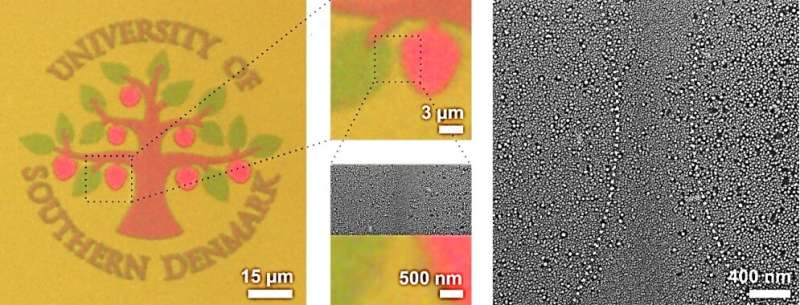January 15, 2019 feature
Bright colors produced by laser heating

Most of the colors on today's paper and fabric are made using dyes or pigments. But colors can also be produced by modifying a material's surface at the nanoscale, causing the surface to reflect or scatter different frequencies of light and giving these materials "structural color." Butterfly wings and bird feathers are examples of materials that naturally exhibit structural color.
In a new study published in ACS Nano, a team of researchers led by Sergey Bozhevolnyi at the University of Southern Denmark has developed a new method for producing bright structural colors on metal films called near-percolation plasmonic reflector arrays. The method uses lasers to heat and reshape tiny (4-nm) gold nanoislands on a silica surface, potentially offering a simple and inexpensive alternative to lithographic nanopatterning.
In order to produce different colors, the laser power is adjusted from 1 to 10 mW. The laser power corresponds to different amounts of heating, which reshapes the gold nanoislands in such a way that they reflect light of different colors. Yellow is produced at low powers, green at intermediate powers, and red at high powers.
The method also produces different results depending on the laser's polarization (light waves are polarized when they are restricted to vibrating only in certain directions). When the laser light is linearly polarized, the colors are clearly seen only when illuminated by light of the same polarization. Circularly polarized laser light, on the other hand, produces polarization-independent colors that are visible using light of any kind of polarization as well as unpolarized light.
The ability to produce both polarization-sensitive and polarization-independent colors could be useful for different types of applications, and the researchers expect that the method could be easily implemented for large-scale use.
"The fabrication procedure for near-percolation reflector arrays is exceedingly simple, requiring only three consecutive material depositions (to produce an optically thick metal back-reflector, a thin dielectric spacer and a very thin semi-continuous metal film) and thereby truly scalable to mass production," the researchers wrote in their paper.
"The unique combination of aforementioned remarkable features makes the approach developed for laser color writing readily amenable for practical implementation and use in diverse applications ranging from nanoscale patterning for security marking to large-scale color printing for decoration."
More information:
Alexander S. Roberts et al. "Laser Writing of Bright Colors on Near-Percolation Plasmonic Reflector Arrays." ACS Nano. DOI: 10.1021/acsnano.8b07541
Also at arXiv:1808.04556 [physics.app-ph]
Journal information: ACS Nano
© 2019 Science X Network


















